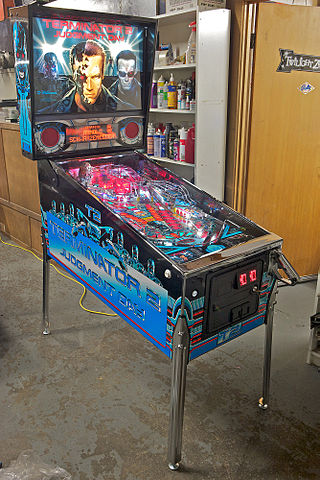
Pinball games are a family of games in which a ball is propelled into a specially designed table where it bounces off various obstacles, scoring points either en route or when it comes to rest. Historically the board was studded with nails called 'pins' and had hollows or pockets which scored points if the ball came to rest in them. Today, pinball is most commonly an arcade game in which the ball is fired into a specially designed cabinet known as a pinball machine, hitting various lights, bumpers, ramps, and other targets depending on its design. The game's object is generally to score as many points as possible by hitting these targets and making various shots with flippers before the ball is lost. Most pinball machines use one ball per turn, and the game ends when the ball(s) from the last turn are lost. The biggest pinball machine manufacturers historically include Bally Manufacturing, Gottlieb, Williams Electronics and Stern Pinball.

WMS Industries, Inc. was an American electronic gaming and amusement manufacturer in Enterprise, Nevada. It was merged into Scientific Games in 2016. WMS's predecessor was the Williams Manufacturing Company, founded in 1943 by Harry E. Williams. However, the company that became WMS Industries was formally founded in 1974 as Williams Electronics, Inc.
A glossary of terms, commonly used in discussing pinball machines.
Christopher P. Granner is a freelance music composer, best known for composing music for video games and pinball games.
Patrick M. Lawlor is a video game and pinball machine designer.
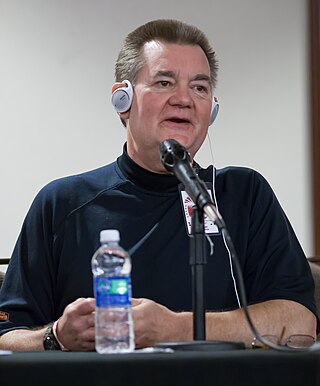
Steven Scott Ritchie is an American pinball and video game designer. His career began in the 1970s, Ritchie holds the record for best-selling pinball designer in history. He has been called "The Master of Flow" due to the emphasis in his designs on ball speed, loops, and long smooth shots. Ritchie was also the original voice of Shao Kahn in the Mortal Kombat fighting game series, serving as the announcer of Mortal Kombat II (1993), Mortal Kombat 3 (1995), and the updates to Mortal Kombat 3. He is the older brother of fellow pinball designer Mark Ritchie.
Digital Compression System, or DCS, is a sound system developed by Williams Electronics. This advanced sound board was used in Williams and Bally pinball games, coin-op arcade video games by Midway Manufacturing, and mechanical and video slot machines by Williams Gaming. This sound system became the standard for these game platforms.

Star Trek: The Next Generation is a widebody pinball game, designed by Steve Ritchie and released in November 1993 by Williams Electronics. It was part of WMS' SuperPin series, and was based on the TV series. It is the only pinball machine that features three separate highscore-lists. Apart from the regular highscore-list and the buy-in-list, it also features a reminiscence to The Machine: Bride of Pin*Bot billionaires club. It is also the third pinball game overall based on the Star Trek franchise, following the 1979 pinball game by Bally, and the 1991 game by Data East, and preceding the 2013 pinball game by Stern.
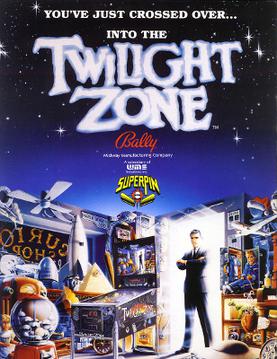
Twilight Zone is a widebody pinball machine, designed by Pat Lawlor and based on the TV series of the same name. It was first released in 1993 by Midway. This game is part of WMS' SuperPin line of widebody games alongside Star Trek: The Next Generation and Indiana Jones: The Pinball Adventure.
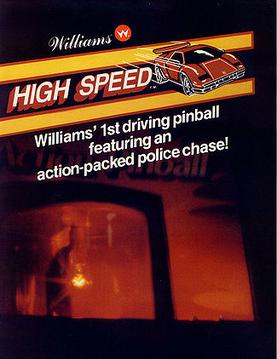
High Speed is a pinball game designed by Steve Ritchie and released by Williams Electronics in 1986. It is based on Ritchie's real-life police chase inside a 1979 Porsche 928. He was finally caught in Lodi, California on Interstate 5 and accused of speeding at 146 miles per hour (235 km/h).
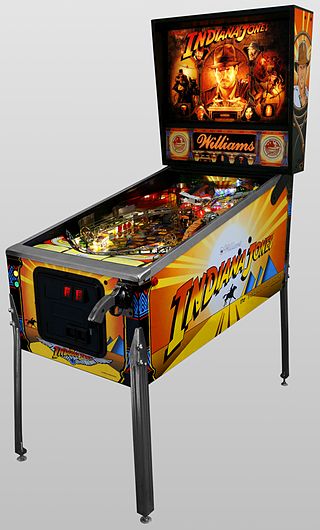
Indiana Jones: The Pinball Adventure is a 1993 widebody pinball game designed by Mark Ritchie and released by Williams. It was based on the Indiana Jones movies. It was also part of WMS' SuperPin series of widebody games.
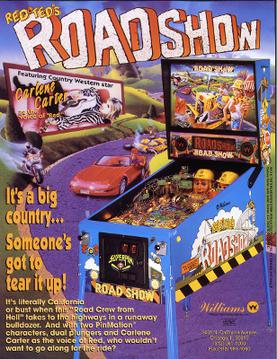
Red & Ted's Road Show is a 1994 widebody pinball game designed by Pat Lawlor and released by Williams. It is part of WMS' SuperPin line of widebody games.
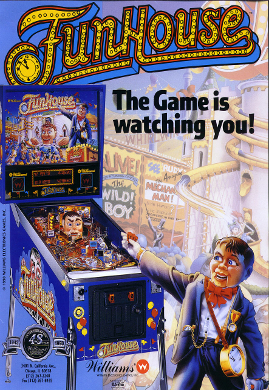
FunHouse is a pinball machine designed by Pat Lawlor and released in November 1990 by Williams Electronics. Starring a talking ventriloquist dummy named Rudy, the game is themed after the concept of an amusement park funhouse. FunHouse is one of the last Williams games to use an alphanumeric display; the company switched to dot matrix the following year.
The Williams Pinball Controller (WPC) is an arcade system board platform used for several pinball games designed by Williams and Midway between 1990 and early 1999. It is the successor to their earlier System 11 hardware. It was succeeded by Williams/Midway's Pinball 2000 platform, before Williams left the pinball business in October 1999.
Brian R. Eddy is an American game designer and programmer, best known for designing Attack From Mars pinball for Midway and programming FunHouse and, with Larry DeMar, The Machine: Bride of Pin*Bot. While at Williams Electronics / Midway Games, he also designed Medieval Madness, and programmed Indiana Jones: The Pinball Adventure.
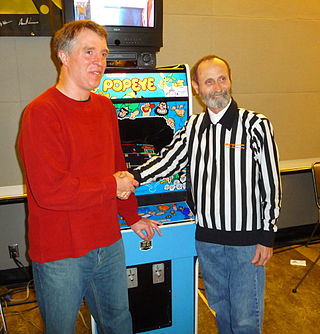
The Northwest Pinball and Arcade Show is an annual pinball and arcade game festival held in Tacoma, Washington, United States.

The Party Zone is a crossover solid-state pinball machine released in 1991 by Midway designed by Dennis Nordman and programmed by Jim Strompolis. It is in a single playfield format and collaborates characters from previous pinball machines. It is the second pinball machine released after the Bally-Midway division was sold, yet still operated under the "Bally" name.

Judge Dredd is a four-player pinball game produced by Bally Manufacturing in 1993, based on the British comic strip Judge Dredd in 2000 AD. Nearly 7,000 were made.

The Pinball Arcade is a pinball video game developed by FarSight Studios. The game is a simulated collection of 100 real pinball tables licensed by Gottlieb, Alvin G. and Company, and Stern Pinball, a company which also owns the rights of machines from Data East and Sega Pinball. Williams and Bally games are no longer available since June 30, 2018, as FarSight had lost the license to WMS properties, which has since passed to Zen Studios.












